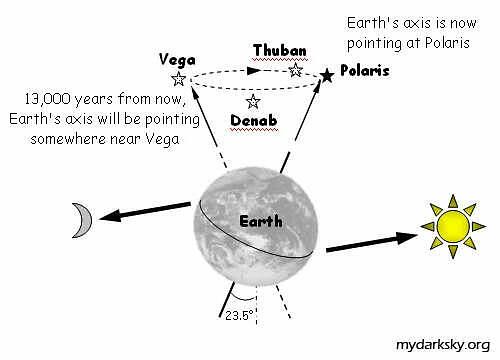ดาวเหนือ - North Star/Pole Star/Polaris
We are in deep water (from rains that come with Mulan), up to our nose with Planet SOS and over our head with political event flooding our Parliament House. Perhaps we should look up – for our guiding stars to help navigate our way out of these messes.
I live down-under in the land of the rainbow serpent. With Polaris Australis as the southern Pole Star. But this star is not particularly bright, so another (not very bright) star pattern called the Southern Cross (look it up in flags and the Net) is a more popular choice. To identify ‘the South’ (direction, not pole) at night, we have to look for the Southern Cross, draw a straight line (in our imagination) from its base (of the cross) to another not very bright star some 2 and a half times the length of the cross and then look down anther length of the cross to spot our South Star and find the South direction. When one relies on a star in finding ones way home, one has to learn such complex method. Else one can die – lost.
Over the equatorial, finding the North at night is much easier. We have a very bright star that quite accurate in showing the direction of the North Pole. North Star or Pole star or Polaris are several names for this star, we would not miss on any unclouded night even when in full moon. (If we can see the Moon, we should not have any problem telling which way is East, and which is North, anyway.)
But let's look beyond our day-to-day frame of reference. Let's look at some things our Earth planet can do, what our galaxy and the whole universe beyond are doing. All are in motion, moving at incredible speeds (but we don't notice at such) and so in vast time and vast distance … what will ‘we’ see?
Can we see that our North Star (now Polaris) will change to star Denob and to star Vega and to star Thuban and back to Polaris again in a cycle of some 25,772 years. No. These stars are not in the same constellation. They are not at the same distance from Earth. They are not the same size nor brightness. But they are ‘seen’ in same circle that our pole axis will draw in the sky. Yes. Some periods of time, we will have to use 2 bright stars to tell where our North is.
And to learn a bit more about space units of distance.

To become astronomers and to explore the universe, we have to start somewhere. Right the ground in the Internet is quite rich, literally littered with what other have learned and what abundance of space probes can tell. Though I feel that, Planet SOS is very loud and urgent, we cannot swim in a little bowl without looking (for hopes) at the bigger picture beyond.
Go ahead download and install ‘Stellarium’ --a free (FOSS) educational tool for all budding astronomers.
ความเห็น (0)
ไม่มีความเห็น
